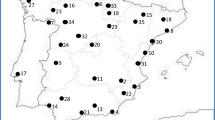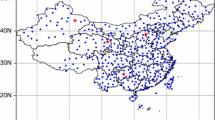Abstract
The spatial variability of monthly diurnal and nocturnal mean values of temperature in Spain has been analysed to evaluate the optimal threshold distance between neighbouring stations that make a meteorological network (in terms of stations’ density) well representative of the conterminous land of Spain. To this end, the correlation decay distance has been calculated using the highest quality monthly available temperature series (1981–2010) from AEMet (National Spanish Meteorological Agency). In the conterminous land of Spain, the distance at which couples of stations have a common variance above the selected threshold (50 %, r Pearson ∼0.70) for both maximum and minimum temperature on average does not exceed 400 km, with relevant spatial and temporal differences, and in extended areas of Spain, this value is lower than 200 km. The spatial variability for minimum temperature is higher than for maximum, except in cold months when the reverse is true. Spatially, highest values are located in both diurnal and nocturnal temperatures to the southeastern coastland and lower spatial variability is found to the inland areas, and thus the spatial variability shows a clear coastland-to-inland gradient at annual and monthly scale. Monthly analyses show that the highest spatial variability in maximum and minimum temperatures occur in July and August, when radiation is maximum, and in lowland areas, (<200 m o.s.l.), which coincide with the mostly transformed landscapes, particularly by irrigation and urbanization. These results highlight local factors could play a major role on spatial variability of temperature. Being maximum and minimum temperature interstation correlation values highly variable in Spanish land, an average of threshold distance of about 200 km as a limit value for a well representative network should be recommended for climate analyses,.




Similar content being viewed by others
References
Agustí A, Thompson R, Livingstone DM (2000) Reconstruction temperature variations at high elevation lake sites in Europe during instrumental period. Verh Int Ver Limnol 27:479–483
Auer I, Böhm R, Jurkovic A et al (2005) A new instrumental precipitation dataset for greater Alpine region for the period 1800-2002. Int J Climatol 25:139–166
Baeza EJ, Perez JJ, Lopez JC et al (2010) Performance of a day/night water heat storage system for heating and cooling of semi-closed greenhouses in mild winter climate. Acta Horticult 927:535–542
Balbontin C, Calera A, Gonzalez J et al (2011) Vineyards evapotranspiration measurements in a semiarid environment: eddy covariance and Bowen ratio comparison. Agrociencia 45:87–103
Betts AK, Desjardins R, Worth D (2013) Cloud radiative forcing of the diurnal cycle climate of the Canadian Prairies. J Geophys Res Atmos. doi:10.1002/jgrd.50593
Bladé I, Castor-Díez Y (2010) Tendencias atmosféricas en la Península Ibérica durante el periodo instrumental en el contexto de la variabilidad natural. In: Perez F and Boscolo R (eds) Clima en España: pasado, presente y futuro. MedCLIVAR Spain. pp 25-42
Briffa KR, Jones PD (1993) Global surface air temperature variations over the twentieth century. Part 2: implication for large scale paleoclimatic studies of the Holocene. The Holocene 3:77–88
Brunet M, Saladie O, Sigro J et al (2006) The development of a new dataset of Spanish Daily Adjusted Temperature Series (SDATS) (1850–2003). Int J Climatol 26:1777–1802
Brunetti M, Maugeri M, Monti F, Nanni T (2006) Temperature and precipitation variability in Italy in the last two centuries from homogenized instrumental time series. Int J Climatol 26:345–381
Caesar J, Alexander L, Voss R (2006) Large-scale changes in observed daily maximum and minimum temperatures: creation and analysis of a new gridded data set. J Geophys Res 111, DO5101. doi:10.1029/2005JD006280
Campra P, Millstein D (2013) Mesoscale climatic simulation of surface air temperature cooling by highly reflective greenhouses in SE Spain. Environ Sci Technol 47:12284–12290
Capel JJ (1981) Los climas de España. Oikos-Tau (Ed), Barcelona, pp 429
Christy JR, Norris W, Redmond K, Gallo KP (2006) Methodology and results of calculating central California surface temperature trends: evidence of human-induced climate change? J Clim 10:548–563
Christy JR, Norris WB, McNider RT (2009) Surface temperature variations in East Africa and possible causes. J Clim 22:3342–3356
Cortesi N, Trigo R, Gonzalez-Hidalgo JC, Ramos A (2013a) Modelling monthly precipitation with circulation weather types for a dense network of stations over Iberia. Hydrol Earth Syst Sci 9:665–678
Cortesi N, Gonzalez-Hidalgo JC, Brunetti M, de Luis M (2013b) Spatial variability of precipitation in Spain. Reg Environ Chang. doi:10.1007/s10113-012-0402-6
Dai A, Trenberth KE, Karl T (1999) Effects of clouds, soil moisture, precipitation, and water vapor on diurnal temperature range. J Clim 12:2451–2473
del Río S, Herrero L, Pinto-Gomes C, Penas A (2011) Spatial analysis of mean temperature trends in Spain over the period 1961–2006. Global Planet Chang 78:65–75
del Rio S, Cano-Ortiz A, Herrero L, Penas A (2012) Recent trends in mean maximum and minimum air temperatures over Spain (1961-2006). Theor Appl Climatol 109:605–626
Durre I, Wallace JM (2001) Factors influencing the cold-seasonal diurnal temperature range in the United States. J Clim 14:3263–3278
Eischeid JK, Baker CB, Karl TR, Díaz HF (1995) The quality control of long term climatological data using objective data analysis. J Appl Meteorol 34:2787–2795
Enríquez E, Del Moral L (2012) Los Incendios Forestales en España. Decenio 2001-2010. Ministerio de Agricultura. Alimentación y Medio Ambiente, Madrid, pp 138
Frías MD, Rodríguez-Puebla C, Zubillaga J (2002) Variability study in winter maximum air temperature over the Iberian Peninsula: a comparison between observations and models. 2. Asamblea Hispano-Portuguesa de Geodesia y Geofísica Valencia, Universidad Politécnica de Valencia
Gandin LS (1988) Complex quality control of meteorological observations. Mon Weather Rev 116:1137–1156
González-Hidalgo JC, Brunetti M, de Luis M (2011) A new tool for monthly precipitation analysis in Spain: MOPREDAS database (monthly precipitation trends December 1945–November 2005). Int J Climatol 31:715–731. doi:10.1002/joc.2115
Gunst R (1995) Estimating spatial correlations from spatial-temporal meteorological data. J Clim 8:2454–2470
Hansen J, Lebedeff S (1987) Global trends of measured surface air temperature. Jr Geophys Res 92:13345–13372
Hofstra N, New M (2009) Spatial variability in correlation decay distance and influence on angular-distance weighting interpolation of daily precipitation over Europe. Int J Climatol 29:1872–1880
Hopkinson RF, Hutchinson MF, McKenney DW et al (2012) Optimizing input data for gridding climate normal for Canada. J Appl Meteorol Climatol 51:1508–1518
Irvine EA, Gray SL, Methven J, Renfrew IA (2011) Forecast impact of targeted observations: sensitivity to observation error and proximity to steep orography. Mon Weather Rev 139:69–78
Jones PD, Briffa KR (1996) What can the instrument records tell us about longer timescale paleoclimatic reconstructions?. In: Bradley RS and Jouzel J (eds) Climate variations and forcing mechanisms of the last 2000 years. NATO ASI Series 141. Springer-Verlag, Berlin-Heidelberg. pp 625–644
Jones PD, Moberg A (2003) Hemispheric and large-scale surface air temperature variations: and extensive revision and update to 2001. J Clim 16:206–223
Jones PD, Osborn TJ, Briffa RK (1997) Estimating sampling errors in large-scale temperature averages. J Clim 10:2548–2568
Kalnay E, Cai M (2003) Impact of urbanization and land-use change on climate. Nature 423:528–531
Kim KY, North GR (1991) Surface temperature fluctuations in a stochastic climate model. J Geophys Res 27:405–430
Klotzbach PJ, Pielke RA Sr, Pielke RA Jr et al (2009) An alternative explanation for differential temperature trends at the surface and the lower troposphere. J Geophys Res 114, D21102. doi:10.1029/2009JD011841
Madden RA, Shea DJ, Branstator GW et al (1993) The effects of imperfect spatial and temporal sampling on estimates of the global mean temperature: experiments with model data. J Clim 6:1057–1066
Mahmood R, Pielke R, Hunnard K et al (2010) Impacts of land use/land cover change on climate and future research priorities. Bull Am Meteorol Soc 91:37–46
Mann M, Park J (1993) Spatial correlation of interdecadal variation in global surface temperatures. Geophys Res Lett 20:1055–1058
Martin-Vide J (2004) Spatial distribution of a daily precipitation concentration index in peninsular Spain. Int J Climatol 24:959–971
McNider RT, Christy JR, Biazar A (2010) A stable boundary layer perspective on global temperature trends. International Conference on Planetary Boundary Layer and Climate Change, IOP Conf. Series: Earth and Environmental Science 13, Number: 012003. Cape Town SA, doi: 10.1088/1755-1315/13/1/012003
Ministerio de Agricultura, Pesca y Alimentación (2009) Encuesta sobre superficies y rendimientos de cultivos. Informe sobre regadíos en España. Publicaciones de la Secretaría General Técnica, Subdirección General de Estadística, Madrid
Mitchell TD, Jones PD (2005) An improved method of constructing a database of monthly climate observations and associated high-resolution grids. Int J Climatol 25:693–712
Moliní F, Salgado M (2010) Superficie artificial y viviendas unifamiliares en España, dentro del debate entre ciudad compacta y dispersa. Bol Asoc Geógrafos Españoles 54:125–147
Moratiel R, Martinez-Cob A (2013) Evapotranspiration and crop coefficients of rice (Oryza sativa L.) under sprinkler irrigation in a semiarid climate determined by the surface renewal method. Irrig Sci 31:411–422
New M, Hulme M, Jones P (2000) Representing twentieth-century space-time climate variability. Part II: development of 1901-1996 monthly grids of terrestrial surface climate. J Clim 13:2217–2238
Osborn TJ, Hulme M (1997) Development of a relationship between station and grid-box rain day frequencies for climate model evaluation. J Clim 10:1885–1908
Pannekoucke O, Berre L, Desroziers G (2008) Background error correlation length-scale estimates and their sampling statistics. Quat J R Meteorol Soc 134:497–511
Peng S, Piao S, Zeng Z et al (2014) Afforestation in China cools local land surface temperature. PNAS 111:2915–2919
Pielke RA, Matsui T (2005) Should light wind and windy nights have the same temperature trends at individual levels even if the boundary layer averaged heat content change is the same? Geophys Res Lett 32, L21813. doi:10.1029/2005GL024407
Raynaud L, Berre L, Desroziers G (2008) Spatial averaging of ensemble-based background-error variances. Quat J R Meteorol Soc 134:1003–1014
Sánchez-Lorenzo A, Sigró J, Calbó J et al. (2008) Efectos de la nubosidad e insolación en las temperaturas recientes de España. In:Sigro J, Brunet M, Aguilar E (Eds) Cambio Climático Regional y sus Impactos. Publicaciones de la Asociación Española de Climatología, Serie A, n° 6, Tarragona, pp 273–283
Shen SSP, Dzikowski P, Li GL, Griffith D (2001) Interpolation of 1961-97 daily temperature and precipitation data onto Alberta polygons of ecodistrict and soil landscapes of Canada. J Appl Climatol 40:2162–2177
Srivastava AK, Rajeevan M, Kshirsagar SR (2009) Development of a high resolution daily gridded temperature data set (1969-2005) for the Indian region. Atmos Sci Lett 10:249–254
Staudt M, Esteban-Parra MJ, Castro-Díez Y (2007) Homogeneization of long-term monthly Spanish temperature data. Int J Climatol 27:1809–1823
Tang Q, Leng G (2009) Changes in cloud cover, precipitation, and summer temperature in North America from 1982 to 2009. J Clim 26:1733–1744
Acknowledgments
Financial support given by Gobierno de España-FSE, Research Project CGL2011-27574-C02-01, and Gobierno Regional de Aragón DGA-FSE, and Grupo de Investigación Consolidado “Clima, Agua, Cambio Global y Sistemas Naturales” (BOA 69, 11-06-2007). Nicola Cortesi and Dhais Peña are PhD students, FPI Program, Gobierno de España. Authors give special thanks for the comments of Dr. S Vicente (IP-CSIC). Data provided by AEMet.
Author information
Authors and Affiliations
Corresponding author
Rights and permissions
About this article
Cite this article
Pena-Angulo, D., Cortesi, N., Brunetti, M. et al. Spatial variability of maximum and minimum monthly temperature in Spain during 1981–2010 evaluated by correlation decay distance (CDD). Theor Appl Climatol 122, 35–45 (2015). https://doi.org/10.1007/s00704-014-1277-x
Received:
Accepted:
Published:
Issue Date:
DOI: https://doi.org/10.1007/s00704-014-1277-x




